Compliance and Deficiencies Report: High-Risk Apartment Building
VerifiedAdded on 2023/06/03
|7
|2349
|310
Report
AI Summary
This report assesses the compliance and deficiencies of a six-story residential apartment building with two basements located on Hamilton Island, Queensland, focusing on both internal and external risk factors. It examines adherence to building regulations, including fire resistance, wind load considerations based on AS/NZS 1170.2, and egress provisions as per the Building Code of Australia (BCA). Key areas of focus include fire safety measures such as fire-rated construction materials, fire walls, and emergency lighting, as well as accessibility considerations outlined in AS 1428.1. The report also addresses health and amenity requirements, including damp proofing, ventilation, and sound insulation, alongside energy efficiency standards to minimize greenhouse gas emissions. Furthermore, it highlights the importance of considering external risks like cyclones, emphasizing the need for cyclone-resistant construction and safe houses within the building. This document is available for students on Desklib, a platform offering a wide range of study tools and resources.
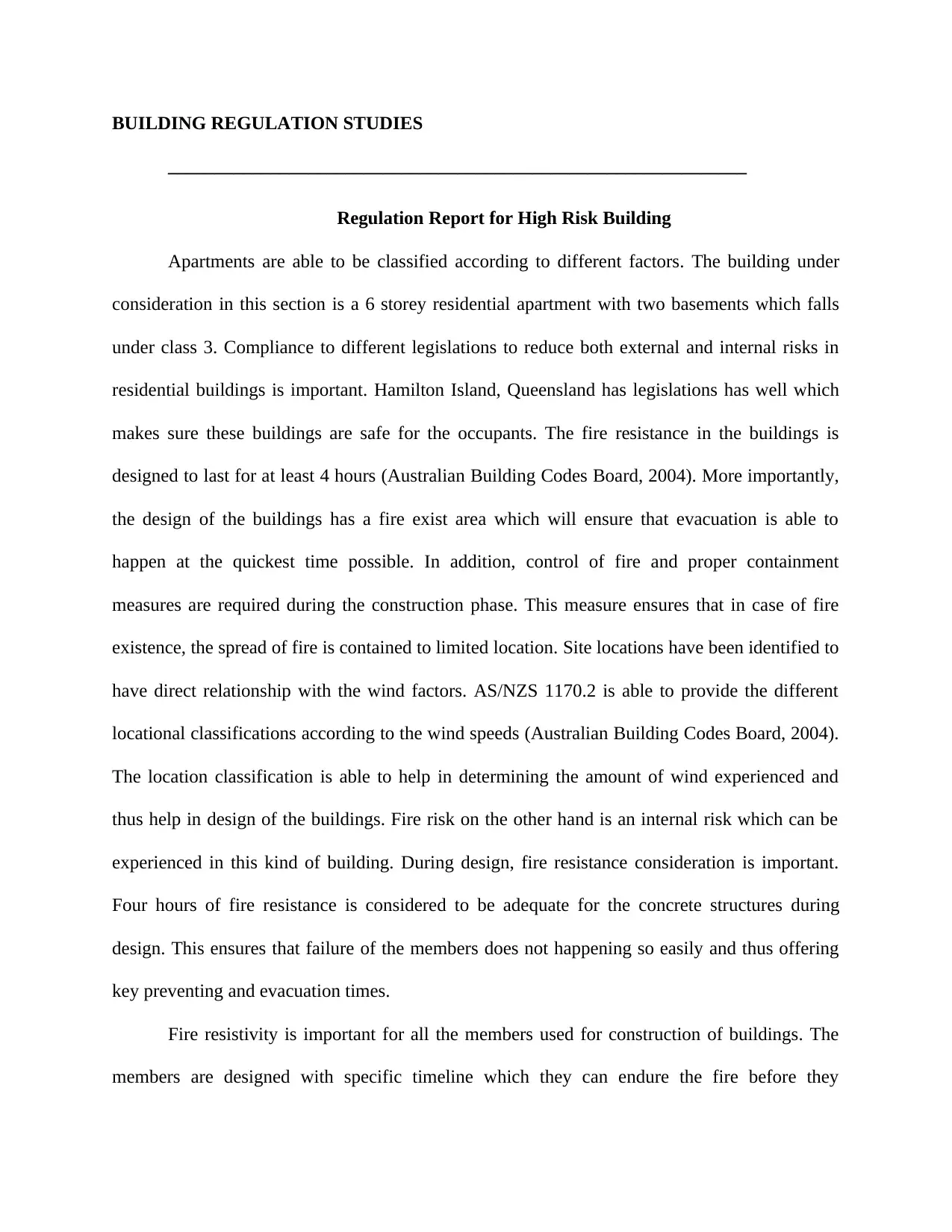
BUILDING REGULATION STUDIES
______________________________________________________________
Regulation Report for High Risk Building
Apartments are able to be classified according to different factors. The building under
consideration in this section is a 6 storey residential apartment with two basements which falls
under class 3. Compliance to different legislations to reduce both external and internal risks in
residential buildings is important. Hamilton Island, Queensland has legislations has well which
makes sure these buildings are safe for the occupants. The fire resistance in the buildings is
designed to last for at least 4 hours (Australian Building Codes Board, 2004). More importantly,
the design of the buildings has a fire exist area which will ensure that evacuation is able to
happen at the quickest time possible. In addition, control of fire and proper containment
measures are required during the construction phase. This measure ensures that in case of fire
existence, the spread of fire is contained to limited location. Site locations have been identified to
have direct relationship with the wind factors. AS/NZS 1170.2 is able to provide the different
locational classifications according to the wind speeds (Australian Building Codes Board, 2004).
The location classification is able to help in determining the amount of wind experienced and
thus help in design of the buildings. Fire risk on the other hand is an internal risk which can be
experienced in this kind of building. During design, fire resistance consideration is important.
Four hours of fire resistance is considered to be adequate for the concrete structures during
design. This ensures that failure of the members does not happening so easily and thus offering
key preventing and evacuation times.
Fire resistivity is important for all the members used for construction of buildings. The
members are designed with specific timeline which they can endure the fire before they
______________________________________________________________
Regulation Report for High Risk Building
Apartments are able to be classified according to different factors. The building under
consideration in this section is a 6 storey residential apartment with two basements which falls
under class 3. Compliance to different legislations to reduce both external and internal risks in
residential buildings is important. Hamilton Island, Queensland has legislations has well which
makes sure these buildings are safe for the occupants. The fire resistance in the buildings is
designed to last for at least 4 hours (Australian Building Codes Board, 2004). More importantly,
the design of the buildings has a fire exist area which will ensure that evacuation is able to
happen at the quickest time possible. In addition, control of fire and proper containment
measures are required during the construction phase. This measure ensures that in case of fire
existence, the spread of fire is contained to limited location. Site locations have been identified to
have direct relationship with the wind factors. AS/NZS 1170.2 is able to provide the different
locational classifications according to the wind speeds (Australian Building Codes Board, 2004).
The location classification is able to help in determining the amount of wind experienced and
thus help in design of the buildings. Fire risk on the other hand is an internal risk which can be
experienced in this kind of building. During design, fire resistance consideration is important.
Four hours of fire resistance is considered to be adequate for the concrete structures during
design. This ensures that failure of the members does not happening so easily and thus offering
key preventing and evacuation times.
Fire resistivity is important for all the members used for construction of buildings. The
members are designed with specific timeline which they can endure the fire before they
Paraphrase This Document
Need a fresh take? Get an instant paraphrase of this document with our AI Paraphraser
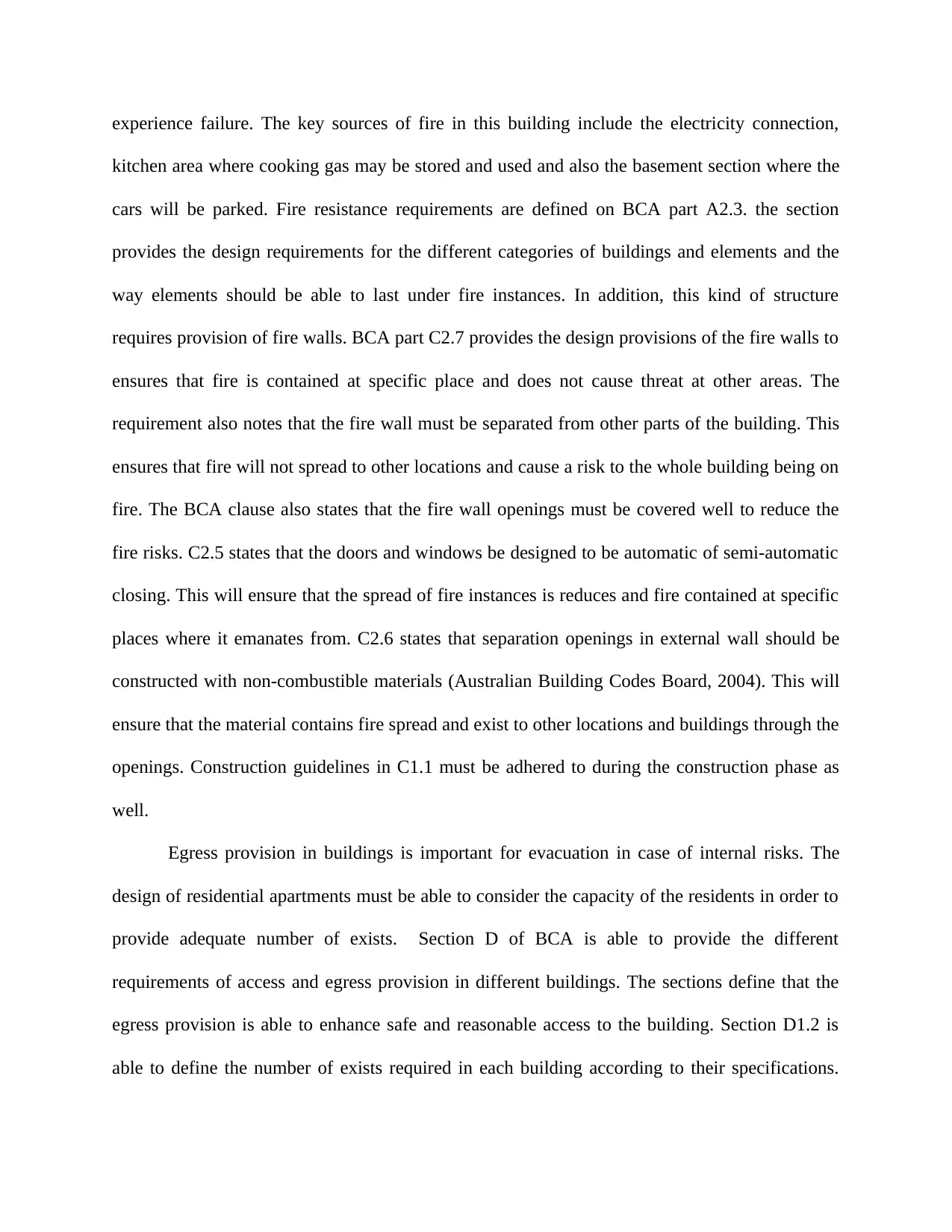
experience failure. The key sources of fire in this building include the electricity connection,
kitchen area where cooking gas may be stored and used and also the basement section where the
cars will be parked. Fire resistance requirements are defined on BCA part A2.3. the section
provides the design requirements for the different categories of buildings and elements and the
way elements should be able to last under fire instances. In addition, this kind of structure
requires provision of fire walls. BCA part C2.7 provides the design provisions of the fire walls to
ensures that fire is contained at specific place and does not cause threat at other areas. The
requirement also notes that the fire wall must be separated from other parts of the building. This
ensures that fire will not spread to other locations and cause a risk to the whole building being on
fire. The BCA clause also states that the fire wall openings must be covered well to reduce the
fire risks. C2.5 states that the doors and windows be designed to be automatic of semi-automatic
closing. This will ensure that the spread of fire instances is reduces and fire contained at specific
places where it emanates from. C2.6 states that separation openings in external wall should be
constructed with non-combustible materials (Australian Building Codes Board, 2004). This will
ensure that the material contains fire spread and exist to other locations and buildings through the
openings. Construction guidelines in C1.1 must be adhered to during the construction phase as
well.
Egress provision in buildings is important for evacuation in case of internal risks. The
design of residential apartments must be able to consider the capacity of the residents in order to
provide adequate number of exists. Section D of BCA is able to provide the different
requirements of access and egress provision in different buildings. The sections define that the
egress provision is able to enhance safe and reasonable access to the building. Section D1.2 is
able to define the number of exists required in each building according to their specifications.
kitchen area where cooking gas may be stored and used and also the basement section where the
cars will be parked. Fire resistance requirements are defined on BCA part A2.3. the section
provides the design requirements for the different categories of buildings and elements and the
way elements should be able to last under fire instances. In addition, this kind of structure
requires provision of fire walls. BCA part C2.7 provides the design provisions of the fire walls to
ensures that fire is contained at specific place and does not cause threat at other areas. The
requirement also notes that the fire wall must be separated from other parts of the building. This
ensures that fire will not spread to other locations and cause a risk to the whole building being on
fire. The BCA clause also states that the fire wall openings must be covered well to reduce the
fire risks. C2.5 states that the doors and windows be designed to be automatic of semi-automatic
closing. This will ensure that the spread of fire instances is reduces and fire contained at specific
places where it emanates from. C2.6 states that separation openings in external wall should be
constructed with non-combustible materials (Australian Building Codes Board, 2004). This will
ensure that the material contains fire spread and exist to other locations and buildings through the
openings. Construction guidelines in C1.1 must be adhered to during the construction phase as
well.
Egress provision in buildings is important for evacuation in case of internal risks. The
design of residential apartments must be able to consider the capacity of the residents in order to
provide adequate number of exists. Section D of BCA is able to provide the different
requirements of access and egress provision in different buildings. The sections define that the
egress provision is able to enhance safe and reasonable access to the building. Section D1.2 is
able to define the number of exists required in each building according to their specifications.
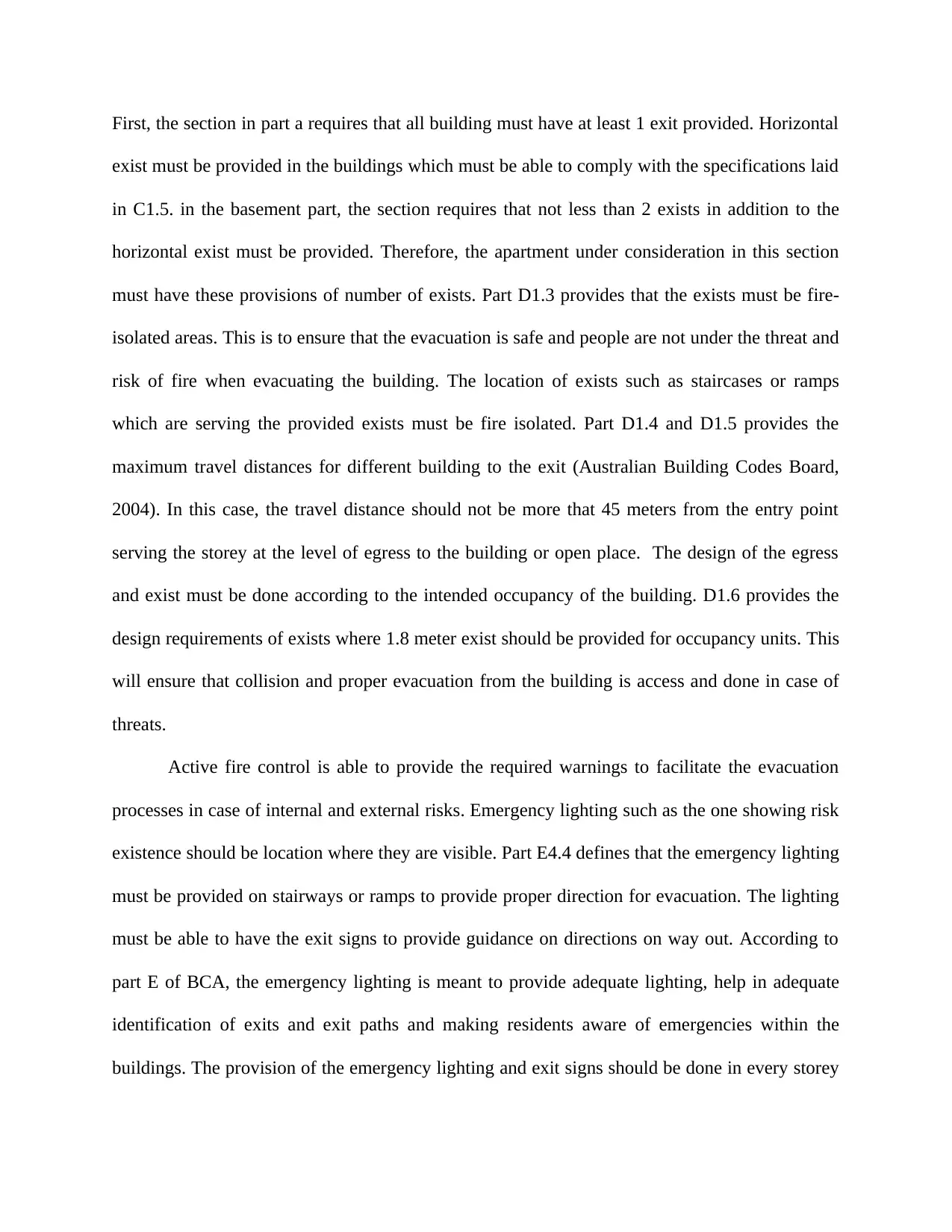
First, the section in part a requires that all building must have at least 1 exit provided. Horizontal
exist must be provided in the buildings which must be able to comply with the specifications laid
in C1.5. in the basement part, the section requires that not less than 2 exists in addition to the
horizontal exist must be provided. Therefore, the apartment under consideration in this section
must have these provisions of number of exists. Part D1.3 provides that the exists must be fire-
isolated areas. This is to ensure that the evacuation is safe and people are not under the threat and
risk of fire when evacuating the building. The location of exists such as staircases or ramps
which are serving the provided exists must be fire isolated. Part D1.4 and D1.5 provides the
maximum travel distances for different building to the exit (Australian Building Codes Board,
2004). In this case, the travel distance should not be more that 45 meters from the entry point
serving the storey at the level of egress to the building or open place. The design of the egress
and exist must be done according to the intended occupancy of the building. D1.6 provides the
design requirements of exists where 1.8 meter exist should be provided for occupancy units. This
will ensure that collision and proper evacuation from the building is access and done in case of
threats.
Active fire control is able to provide the required warnings to facilitate the evacuation
processes in case of internal and external risks. Emergency lighting such as the one showing risk
existence should be location where they are visible. Part E4.4 defines that the emergency lighting
must be provided on stairways or ramps to provide proper direction for evacuation. The lighting
must be able to have the exit signs to provide guidance on directions on way out. According to
part E of BCA, the emergency lighting is meant to provide adequate lighting, help in adequate
identification of exits and exit paths and making residents aware of emergencies within the
buildings. The provision of the emergency lighting and exit signs should be done in every storey
exist must be provided in the buildings which must be able to comply with the specifications laid
in C1.5. in the basement part, the section requires that not less than 2 exists in addition to the
horizontal exist must be provided. Therefore, the apartment under consideration in this section
must have these provisions of number of exists. Part D1.3 provides that the exists must be fire-
isolated areas. This is to ensure that the evacuation is safe and people are not under the threat and
risk of fire when evacuating the building. The location of exists such as staircases or ramps
which are serving the provided exists must be fire isolated. Part D1.4 and D1.5 provides the
maximum travel distances for different building to the exit (Australian Building Codes Board,
2004). In this case, the travel distance should not be more that 45 meters from the entry point
serving the storey at the level of egress to the building or open place. The design of the egress
and exist must be done according to the intended occupancy of the building. D1.6 provides the
design requirements of exists where 1.8 meter exist should be provided for occupancy units. This
will ensure that collision and proper evacuation from the building is access and done in case of
threats.
Active fire control is able to provide the required warnings to facilitate the evacuation
processes in case of internal and external risks. Emergency lighting such as the one showing risk
existence should be location where they are visible. Part E4.4 defines that the emergency lighting
must be provided on stairways or ramps to provide proper direction for evacuation. The lighting
must be able to have the exit signs to provide guidance on directions on way out. According to
part E of BCA, the emergency lighting is meant to provide adequate lighting, help in adequate
identification of exits and exit paths and making residents aware of emergencies within the
buildings. The provision of the emergency lighting and exit signs should be done in every storey
⊘ This is a preview!⊘
Do you want full access?
Subscribe today to unlock all pages.

Trusted by 1+ million students worldwide
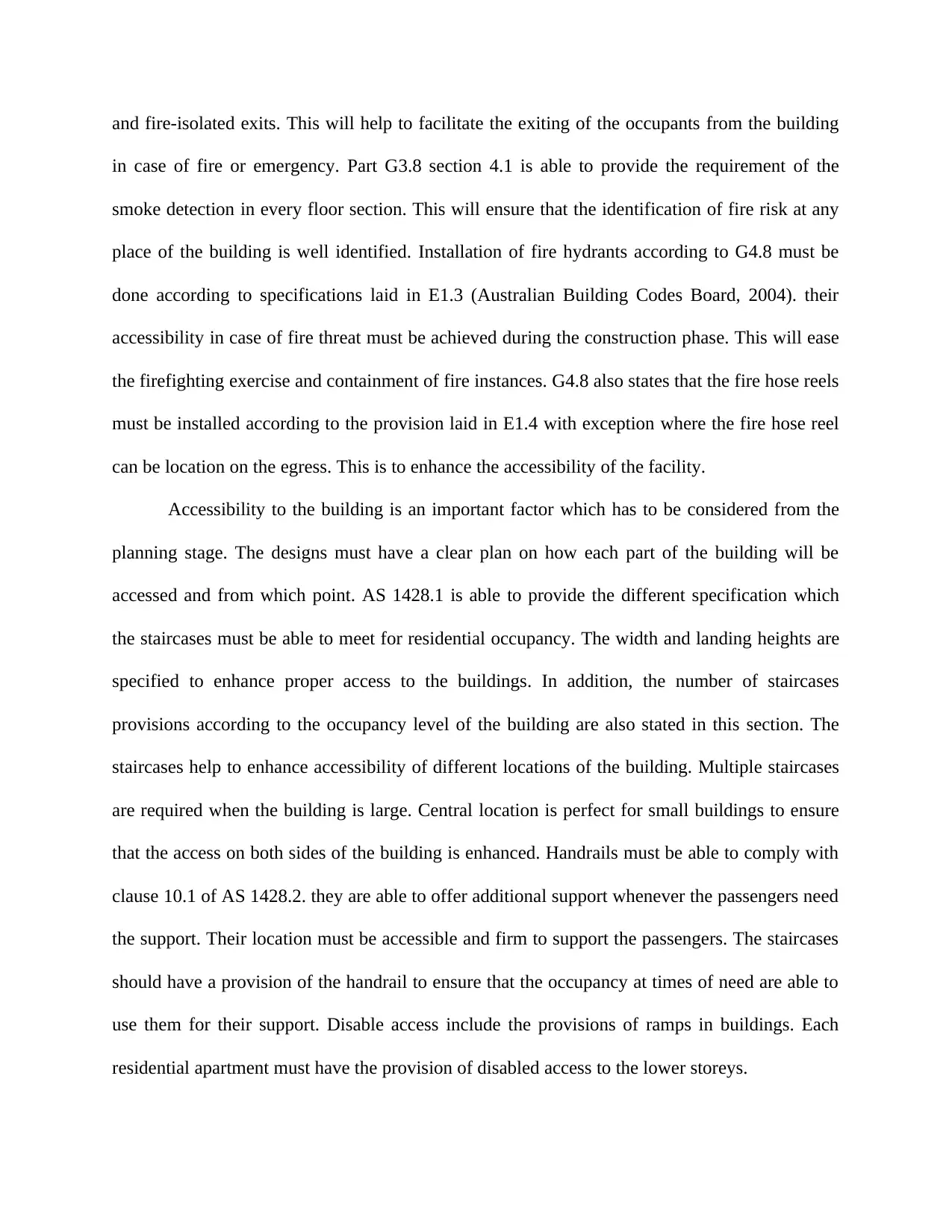
and fire-isolated exits. This will help to facilitate the exiting of the occupants from the building
in case of fire or emergency. Part G3.8 section 4.1 is able to provide the requirement of the
smoke detection in every floor section. This will ensure that the identification of fire risk at any
place of the building is well identified. Installation of fire hydrants according to G4.8 must be
done according to specifications laid in E1.3 (Australian Building Codes Board, 2004). their
accessibility in case of fire threat must be achieved during the construction phase. This will ease
the firefighting exercise and containment of fire instances. G4.8 also states that the fire hose reels
must be installed according to the provision laid in E1.4 with exception where the fire hose reel
can be location on the egress. This is to enhance the accessibility of the facility.
Accessibility to the building is an important factor which has to be considered from the
planning stage. The designs must have a clear plan on how each part of the building will be
accessed and from which point. AS 1428.1 is able to provide the different specification which
the staircases must be able to meet for residential occupancy. The width and landing heights are
specified to enhance proper access to the buildings. In addition, the number of staircases
provisions according to the occupancy level of the building are also stated in this section. The
staircases help to enhance accessibility of different locations of the building. Multiple staircases
are required when the building is large. Central location is perfect for small buildings to ensure
that the access on both sides of the building is enhanced. Handrails must be able to comply with
clause 10.1 of AS 1428.2. they are able to offer additional support whenever the passengers need
the support. Their location must be accessible and firm to support the passengers. The staircases
should have a provision of the handrail to ensure that the occupancy at times of need are able to
use them for their support. Disable access include the provisions of ramps in buildings. Each
residential apartment must have the provision of disabled access to the lower storeys.
in case of fire or emergency. Part G3.8 section 4.1 is able to provide the requirement of the
smoke detection in every floor section. This will ensure that the identification of fire risk at any
place of the building is well identified. Installation of fire hydrants according to G4.8 must be
done according to specifications laid in E1.3 (Australian Building Codes Board, 2004). their
accessibility in case of fire threat must be achieved during the construction phase. This will ease
the firefighting exercise and containment of fire instances. G4.8 also states that the fire hose reels
must be installed according to the provision laid in E1.4 with exception where the fire hose reel
can be location on the egress. This is to enhance the accessibility of the facility.
Accessibility to the building is an important factor which has to be considered from the
planning stage. The designs must have a clear plan on how each part of the building will be
accessed and from which point. AS 1428.1 is able to provide the different specification which
the staircases must be able to meet for residential occupancy. The width and landing heights are
specified to enhance proper access to the buildings. In addition, the number of staircases
provisions according to the occupancy level of the building are also stated in this section. The
staircases help to enhance accessibility of different locations of the building. Multiple staircases
are required when the building is large. Central location is perfect for small buildings to ensure
that the access on both sides of the building is enhanced. Handrails must be able to comply with
clause 10.1 of AS 1428.2. they are able to offer additional support whenever the passengers need
the support. Their location must be accessible and firm to support the passengers. The staircases
should have a provision of the handrail to ensure that the occupancy at times of need are able to
use them for their support. Disable access include the provisions of ramps in buildings. Each
residential apartment must have the provision of disabled access to the lower storeys.
Paraphrase This Document
Need a fresh take? Get an instant paraphrase of this document with our AI Paraphraser
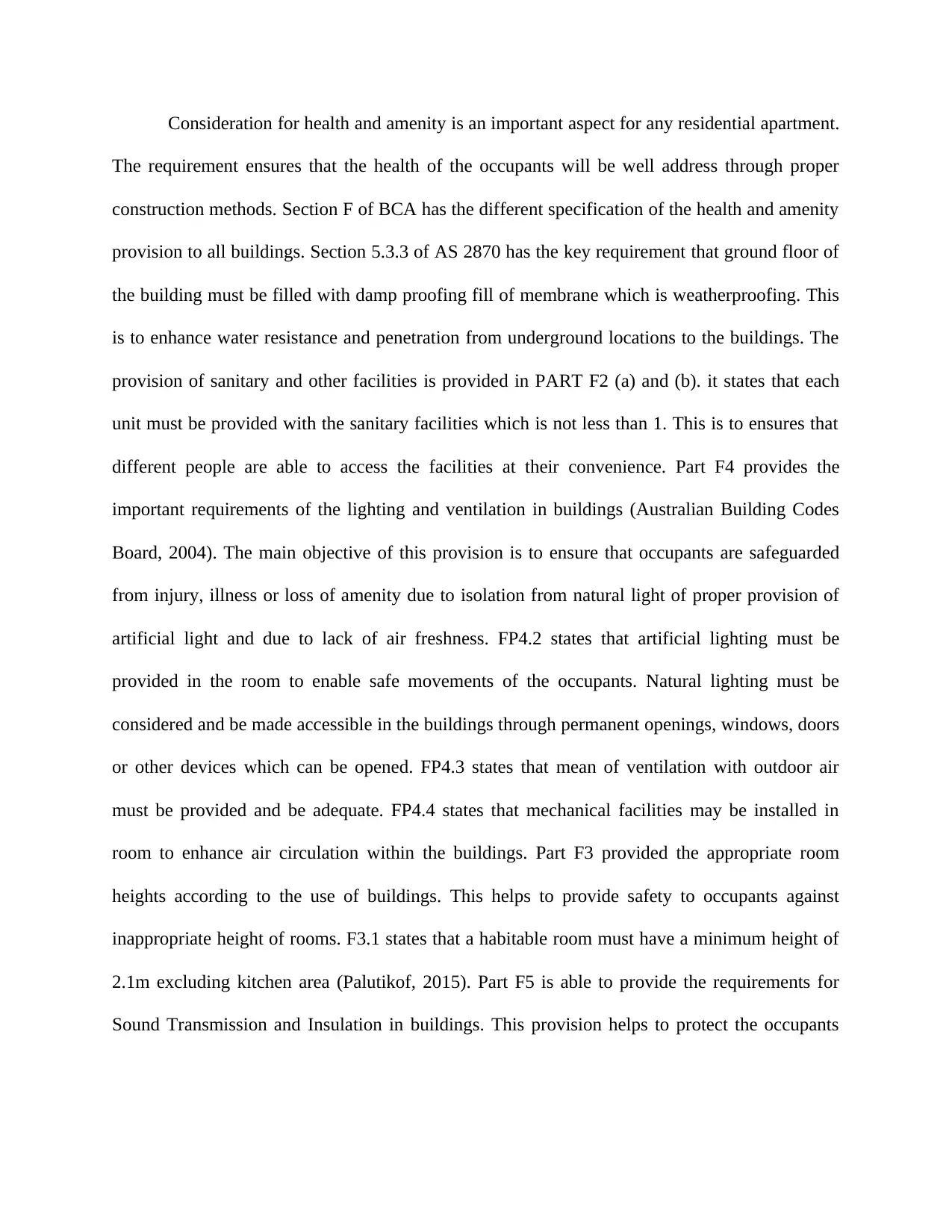
Consideration for health and amenity is an important aspect for any residential apartment.
The requirement ensures that the health of the occupants will be well address through proper
construction methods. Section F of BCA has the different specification of the health and amenity
provision to all buildings. Section 5.3.3 of AS 2870 has the key requirement that ground floor of
the building must be filled with damp proofing fill of membrane which is weatherproofing. This
is to enhance water resistance and penetration from underground locations to the buildings. The
provision of sanitary and other facilities is provided in PART F2 (a) and (b). it states that each
unit must be provided with the sanitary facilities which is not less than 1. This is to ensures that
different people are able to access the facilities at their convenience. Part F4 provides the
important requirements of the lighting and ventilation in buildings (Australian Building Codes
Board, 2004). The main objective of this provision is to ensure that occupants are safeguarded
from injury, illness or loss of amenity due to isolation from natural light of proper provision of
artificial light and due to lack of air freshness. FP4.2 states that artificial lighting must be
provided in the room to enable safe movements of the occupants. Natural lighting must be
considered and be made accessible in the buildings through permanent openings, windows, doors
or other devices which can be opened. FP4.3 states that mean of ventilation with outdoor air
must be provided and be adequate. FP4.4 states that mechanical facilities may be installed in
room to enhance air circulation within the buildings. Part F3 provided the appropriate room
heights according to the use of buildings. This helps to provide safety to occupants against
inappropriate height of rooms. F3.1 states that a habitable room must have a minimum height of
2.1m excluding kitchen area (Palutikof, 2015). Part F5 is able to provide the requirements for
Sound Transmission and Insulation in buildings. This provision helps to protect the occupants
The requirement ensures that the health of the occupants will be well address through proper
construction methods. Section F of BCA has the different specification of the health and amenity
provision to all buildings. Section 5.3.3 of AS 2870 has the key requirement that ground floor of
the building must be filled with damp proofing fill of membrane which is weatherproofing. This
is to enhance water resistance and penetration from underground locations to the buildings. The
provision of sanitary and other facilities is provided in PART F2 (a) and (b). it states that each
unit must be provided with the sanitary facilities which is not less than 1. This is to ensures that
different people are able to access the facilities at their convenience. Part F4 provides the
important requirements of the lighting and ventilation in buildings (Australian Building Codes
Board, 2004). The main objective of this provision is to ensure that occupants are safeguarded
from injury, illness or loss of amenity due to isolation from natural light of proper provision of
artificial light and due to lack of air freshness. FP4.2 states that artificial lighting must be
provided in the room to enable safe movements of the occupants. Natural lighting must be
considered and be made accessible in the buildings through permanent openings, windows, doors
or other devices which can be opened. FP4.3 states that mean of ventilation with outdoor air
must be provided and be adequate. FP4.4 states that mechanical facilities may be installed in
room to enhance air circulation within the buildings. Part F3 provided the appropriate room
heights according to the use of buildings. This helps to provide safety to occupants against
inappropriate height of rooms. F3.1 states that a habitable room must have a minimum height of
2.1m excluding kitchen area (Palutikof, 2015). Part F5 is able to provide the requirements for
Sound Transmission and Insulation in buildings. This provision helps to protect the occupants
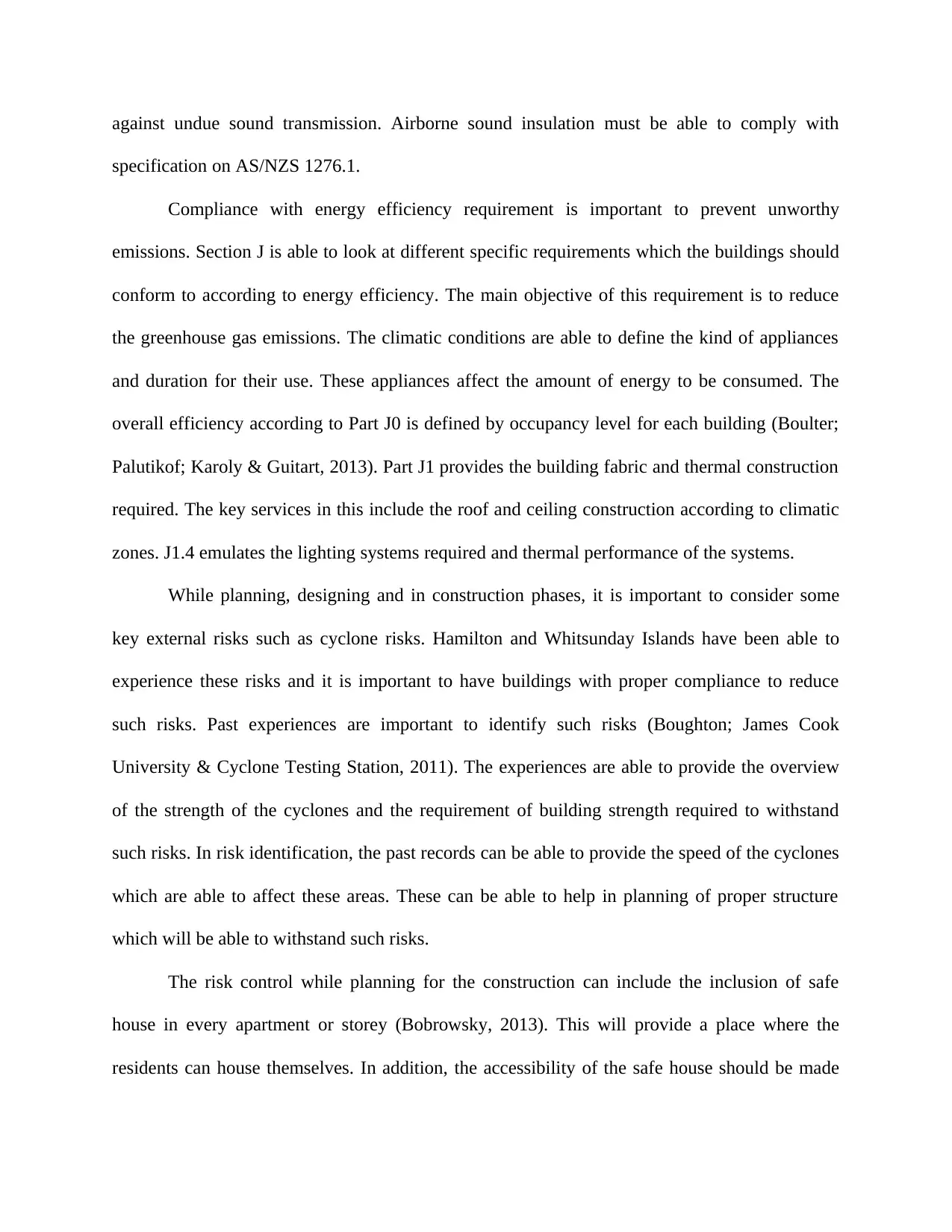
against undue sound transmission. Airborne sound insulation must be able to comply with
specification on AS/NZS 1276.1.
Compliance with energy efficiency requirement is important to prevent unworthy
emissions. Section J is able to look at different specific requirements which the buildings should
conform to according to energy efficiency. The main objective of this requirement is to reduce
the greenhouse gas emissions. The climatic conditions are able to define the kind of appliances
and duration for their use. These appliances affect the amount of energy to be consumed. The
overall efficiency according to Part J0 is defined by occupancy level for each building (Boulter;
Palutikof; Karoly & Guitart, 2013). Part J1 provides the building fabric and thermal construction
required. The key services in this include the roof and ceiling construction according to climatic
zones. J1.4 emulates the lighting systems required and thermal performance of the systems.
While planning, designing and in construction phases, it is important to consider some
key external risks such as cyclone risks. Hamilton and Whitsunday Islands have been able to
experience these risks and it is important to have buildings with proper compliance to reduce
such risks. Past experiences are important to identify such risks (Boughton; James Cook
University & Cyclone Testing Station, 2011). The experiences are able to provide the overview
of the strength of the cyclones and the requirement of building strength required to withstand
such risks. In risk identification, the past records can be able to provide the speed of the cyclones
which are able to affect these areas. These can be able to help in planning of proper structure
which will be able to withstand such risks.
The risk control while planning for the construction can include the inclusion of safe
house in every apartment or storey (Bobrowsky, 2013). This will provide a place where the
residents can house themselves. In addition, the accessibility of the safe house should be made
specification on AS/NZS 1276.1.
Compliance with energy efficiency requirement is important to prevent unworthy
emissions. Section J is able to look at different specific requirements which the buildings should
conform to according to energy efficiency. The main objective of this requirement is to reduce
the greenhouse gas emissions. The climatic conditions are able to define the kind of appliances
and duration for their use. These appliances affect the amount of energy to be consumed. The
overall efficiency according to Part J0 is defined by occupancy level for each building (Boulter;
Palutikof; Karoly & Guitart, 2013). Part J1 provides the building fabric and thermal construction
required. The key services in this include the roof and ceiling construction according to climatic
zones. J1.4 emulates the lighting systems required and thermal performance of the systems.
While planning, designing and in construction phases, it is important to consider some
key external risks such as cyclone risks. Hamilton and Whitsunday Islands have been able to
experience these risks and it is important to have buildings with proper compliance to reduce
such risks. Past experiences are important to identify such risks (Boughton; James Cook
University & Cyclone Testing Station, 2011). The experiences are able to provide the overview
of the strength of the cyclones and the requirement of building strength required to withstand
such risks. In risk identification, the past records can be able to provide the speed of the cyclones
which are able to affect these areas. These can be able to help in planning of proper structure
which will be able to withstand such risks.
The risk control while planning for the construction can include the inclusion of safe
house in every apartment or storey (Bobrowsky, 2013). This will provide a place where the
residents can house themselves. In addition, the accessibility of the safe house should be made
⊘ This is a preview!⊘
Do you want full access?
Subscribe today to unlock all pages.

Trusted by 1+ million students worldwide
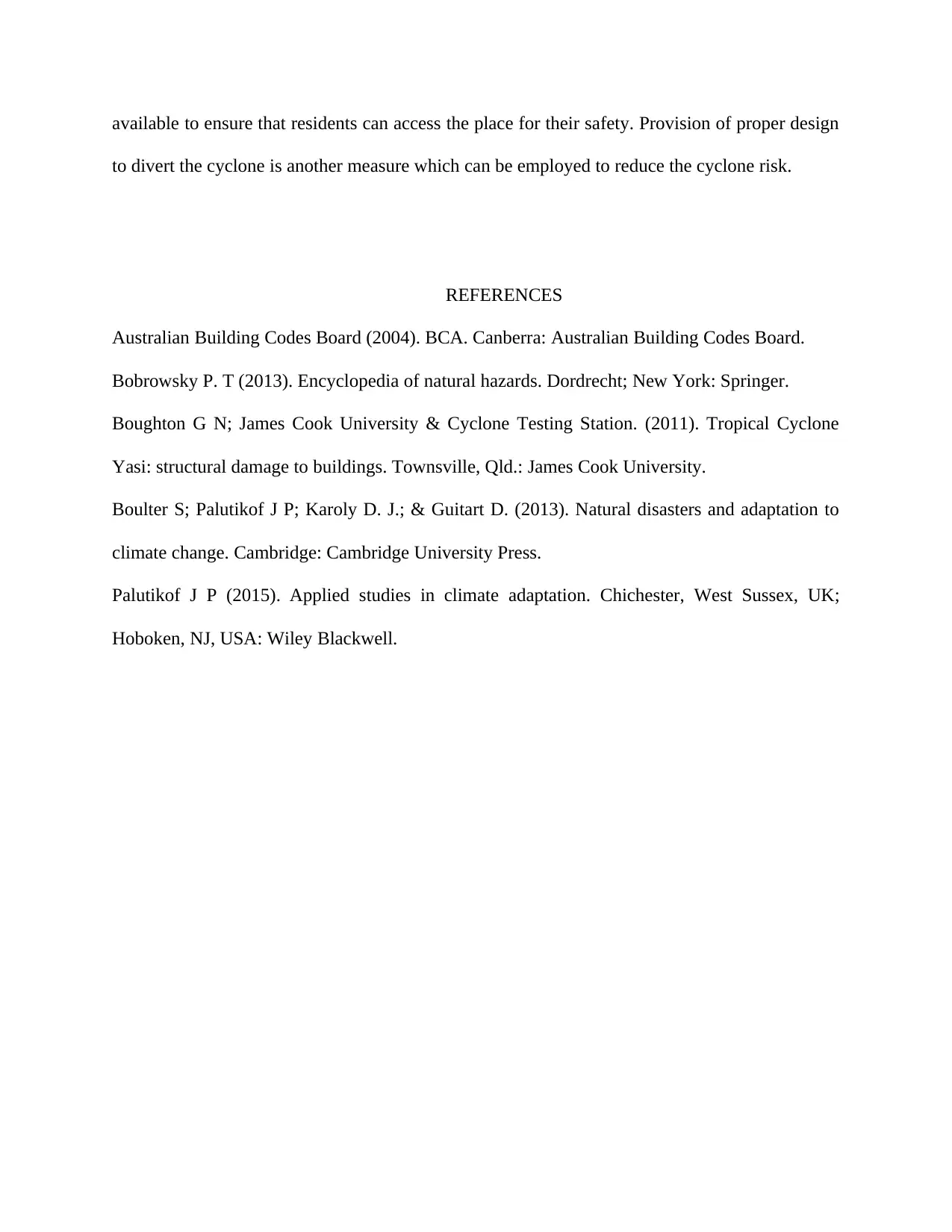
available to ensure that residents can access the place for their safety. Provision of proper design
to divert the cyclone is another measure which can be employed to reduce the cyclone risk.
REFERENCES
Australian Building Codes Board (2004). BCA. Canberra: Australian Building Codes Board.
Bobrowsky P. T (2013). Encyclopedia of natural hazards. Dordrecht; New York: Springer.
Boughton G N; James Cook University & Cyclone Testing Station. (2011). Tropical Cyclone
Yasi: structural damage to buildings. Townsville, Qld.: James Cook University.
Boulter S; Palutikof J P; Karoly D. J.; & Guitart D. (2013). Natural disasters and adaptation to
climate change. Cambridge: Cambridge University Press.
Palutikof J P (2015). Applied studies in climate adaptation. Chichester, West Sussex, UK;
Hoboken, NJ, USA: Wiley Blackwell.
to divert the cyclone is another measure which can be employed to reduce the cyclone risk.
REFERENCES
Australian Building Codes Board (2004). BCA. Canberra: Australian Building Codes Board.
Bobrowsky P. T (2013). Encyclopedia of natural hazards. Dordrecht; New York: Springer.
Boughton G N; James Cook University & Cyclone Testing Station. (2011). Tropical Cyclone
Yasi: structural damage to buildings. Townsville, Qld.: James Cook University.
Boulter S; Palutikof J P; Karoly D. J.; & Guitart D. (2013). Natural disasters and adaptation to
climate change. Cambridge: Cambridge University Press.
Palutikof J P (2015). Applied studies in climate adaptation. Chichester, West Sussex, UK;
Hoboken, NJ, USA: Wiley Blackwell.
1 out of 7
Related Documents
Your All-in-One AI-Powered Toolkit for Academic Success.
+13062052269
info@desklib.com
Available 24*7 on WhatsApp / Email
![[object Object]](/_next/static/media/star-bottom.7253800d.svg)
Unlock your academic potential
Copyright © 2020–2025 A2Z Services. All Rights Reserved. Developed and managed by ZUCOL.





